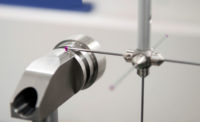In today’s aerospace manufacturing environment, compliance to standards such as AS9100 is often not optional. A critical part of the AS9100 process involves first article inspection reports.
LORD Corp. describes a First Article Inspection (FAI) as “A complete verification that the article being inspected complies with the requirements identified in engineering drawings, specifications, and purchase order as well as any other applicable design requirement(s). The FAI package shall include the FAI form, annotated drawing, and all supporting documentation (i.e certifications, test reports, etc). Note: The FAI may also be referred to as a First Article Inspection Report (FAIR) or an Initial Sample Inspection Report (ISIR).”
While these reports are required, with the right tools, the documents don’t necessarily have to take all day to complete. In other words, it doesn’t have to be so difficult. Inspection reporting can be a slog, with manual data entry, time-consuming revisions and seemingly endless reports to get through each week. But the right technology can change all this.
One manufacturer found this out after adopting a new software solution.
As with many companies, 110 Metalworks (formerly Precision Systems MFG, Inc.) handles a diverse customer base. The Liverpool, NY-based company offers high-quality metal products for a range of industries, including aerospace transport, industrial equipment and machinery, defense electronics and tactical vehicles, material handling, electronics and telecommunications, medical and scientific equipment, and HVAC. Customers include Lockheed Martin, Thermo Fisher Scientific and Mettler Toledo.
With their work in aerospace, it was clear that AS9102 compliance was no minor undertaking. It required extensive documentation, which could be time-consuming. The company found that the ballooning of a drawing and the creating of an inspection report would usually take a few hours. At least it used to. The company adopted a new solution that changed all this.
The quality systems technician at 110 Metalworks tried DISCUS software for AS9102 in 2008 and they haven’t looked back. They found they were able to reduce the time required to generate these documents by almost half. They’ve been using the software since that trial and it helped both 110 Metalworks and their customers as well.
According to Michael Parsley, quality systems specialist at 110 Metalworks, “Using DISCUS takes about half the time as it would to create the AS9102 forms by hand. The ability of adding specification details is a wonderful bonus.”
Imagine having twice as much time to get your work done. It’s not quite the same as getting more hours in the day—or more staff members—but it is still an appealing prospect to have your regular workload take half the time. It could lead to more time to develop skills and improve other processes.
And any quality professional can attest that lack of time can get in the way of quality processes. In fact, in the 2018 Quality State of the Profession Survey, time constraints were cited by 51% of respondents as one of the biggest job barriers in the next 12 months. In the 2020 survey, time constraints no doubt still existed but respondents were most concerned about workforce skill improvement.
With time being so precious, there are a few features that often help speed up the time to create inspection reports. These vary software by software and you may get more mileage out of certain features than others.
In the case of DISCUS 2020, the latest release includes features such as the ability to change the weight of balloon outlines and leader lines; the hidden ability to provide support for .dwg and .dxf 2D CAD files; and the ability to append the number of places to the requirement description field when the number of places of greater than 1, in the format “yX”, where y=places. Other notable new features are: adding features to decrease the number of steps required to apply balloon property changes to existing characteristics as well as the ability to export to Excel the Operation Analysis data when the DISCUS Planner add-on module is enabled.
Many of these new features were added per customer request but also out of a recognized need to make software more intuitive. If you have questions about any of these features, training is available.
Though the standards do require time to implement, they are important in verifying quality, which is why AS9100 is so essential. While AS9100 may not be required, it is often intended to show how a company adheres to quality processes. According to SAhttps://saemobilus.sae.org/content/AS9100D/E, “This International Standard specifies requirements for a quality management system when an organization:
needs to demonstrate its ability to consistently provide products and services that meet customer and applicable statutory and regulatory requirements, and
aims to enhance customer satisfaction through the effective application of the system, including processes for improvement of the system and the assurance of conformity to customer and applicable statutory and regulatory requirements.”
It may sound daunting but it is worth the effort, as NQA explains: “Because AS9100 certification helps ensure an organization has adequate quality management systems in place, many aerospace manufacturers and suppliers will work only with certified partners. As a result, AS9100 certification is important for any aerospace-related company to consider.”







